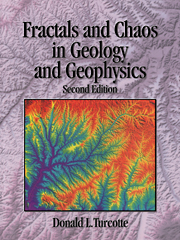Book contents
- Frontmatter
- Contents
- Preface
- Preface to the second edition
- 1 Scale invariance
- 2 Definition of a fractal set
- 3 Fragmentation
- 4 Seismicity and tectonics
- 5 Ore grade and tonnage
- 6 Fractal clustering
- 7 Self-affine fractals
- 8 Geomorphology
- 9 Dynamical systems
- 10 Logistic map
- 11 Slider-block models
- 12 Lorenz equations
- 13 Is mantle convection chaotic?
- 14 Rikitake dynamo
- 15 Renormalization group method
- 16 Self-organized criticality
- 17 Where do we stand?
- References
- Appendix A Glossary of terms
- Appendix B Units and symbols
- Answers to selected problems
- Index
7 - Self-affine fractals
Published online by Cambridge University Press: 05 June 2012
- Frontmatter
- Contents
- Preface
- Preface to the second edition
- 1 Scale invariance
- 2 Definition of a fractal set
- 3 Fragmentation
- 4 Seismicity and tectonics
- 5 Ore grade and tonnage
- 6 Fractal clustering
- 7 Self-affine fractals
- 8 Geomorphology
- 9 Dynamical systems
- 10 Logistic map
- 11 Slider-block models
- 12 Lorenz equations
- 13 Is mantle convection chaotic?
- 14 Rikitake dynamo
- 15 Renormalization group method
- 16 Self-organized criticality
- 17 Where do we stand?
- References
- Appendix A Glossary of terms
- Appendix B Units and symbols
- Answers to selected problems
- Index
Summary
Definition of a self-affine fractal
Up to this point we have considered self-similar fractals; we now turn to self-affine fractals (Mandelbrot, 1985). Topography is an example of both. In the two horizontal directions topography is often self-similar; the ruler method can be applied to a coastline or to a contour on a topographic map to define a fractal dimension. The box-counting method can also be applied to a coastline, and square boxes are used to determine a fractal dimension. These are examples of self-similar fractals. Consider next the elevation of topography. Three examples of elevation h as a function of distance x along linear tracks are given in Figure 7.1. The vertical coordinate is statistically related to the horizontal coordinate but systematically has a smaller magnitude. Vertical cross sections of this type are often examples of self-affine fractals (Dubuc et al., 1989a).
A statistically self-similar fractal is by definition isotropic. In two dimensions defined by x and y coordinates the results do not depend on the geometrical orientation of the x- and y-axes. This principle was illustrated in Figure 2.8, where the box-counting method was introduced. The fractal dimension of a rocky coastline is independent of the orientation of the boxes. A formal definition of a self-similar fractal in a two-dimensional xy-space is that f(rx, ry) is statistically similar to f(x, y) where r is a scaling factor. This result is quantified by applications of the fractal relation (2.6).
- Type
- Chapter
- Information
- Fractals and Chaos in Geology and Geophysics , pp. 132 - 182Publisher: Cambridge University PressPrint publication year: 1997



